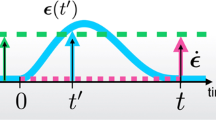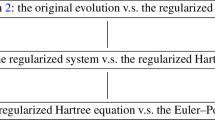Abstract
This paper shows that the general homogeneous solution to equations of evolution for some infinite systems of particles subject to mutual binary collisions does not depend on a single arbitrary constant but on a potentially infinite number of such constants. This is because, as I demonstrate, a single self-excitation of a system of particles can depend on a potentially infinite number of parameters. The recent homogeneous solution obtained by Atkinson and Johnson, which depends on a single arbitrary constant, is only a particular case.
Similar content being viewed by others
Notes
The Atkinson–Johnson treatment is of interest because it explicitly showed that indeterminism may occur in situations in which no pair of particles is at relative rest. Until then, all that had usually been proved was the existence of indeterminism, with supertasks, by temporally inverting final states of relative rest, as is done systematically in [4].
Note that \(\beta _{0}\) is determined by the initial conditions before self-excitation, which means that the only arbitrary (undetermined) parameter is \(\gamma \).
Here I consider only the classic non-relativistic case. This is justified by its greater simplicity, as the ideas that I discuss later may in principle be extended directly to the relativistic case.
There is an infinite number of solutions for this recurring equation for \(\mu _\mathrm{n}\) which lead to a finite total mass, which agrees with Atkinson and Johnson’s result. One of the simpler ones is \(\mu _\mathrm{n}\) = n/(n + 2). Taking then, for instance, m\(_{1}\) = 1 we have successively m\(_{2}\) = 2/(2\(\cdot \)3), m\(_{3}\) = 2/(3\(\cdot \)4),..., m\(_\mathrm{n}\) = 2/(n\(\cdot \)(n+1)),.....As m\(_\mathrm{n} \le \) 2/n\(^{2}\) and the series \(\Sigma _{n = 1}^{n = \infty }\) (2/n\(^{2})\) is convergent, it follows that \(\Sigma _{n = 1}^{n = \infty }\) m\(_\mathrm{n}\) also is.
In purely algebraic terms, the limitation of Atkinson–Johnson stems from their implicit assumption that (as we saw in Sect. 1) a self-excitation has as a consequence that each particle p\(_\mathrm{n}\) (except p\(_{0})\) acquires exactly two velocities. The first through its collision with p\(_\mathrm{n+1}\) and the second through its collision with p\(_\mathrm{n-1}\). The treatment in Sect. 3 shows that this is not what is to be expected in general.
For instance [5] took advantage of this evident liberty to prove the possibility of the spontaneous self-acceleration of infinite systems of particles of finite total mass by means of binary collisions.
References
Atkinson, D.: Losing energy in classical, relativistic and quantum mechanics. Stud. Hist. Philos. Mod. Phys. 38, 170–180 (2007)
Atkinson, D., Johnson, P.: Nonconservation of energy and loss of determinism I. Infinitely many colliding balls. Found. Phys. 39, 937–957 (2009)
Laraudogoitia, J.P.: A beautiful supertask. Mind 105, 81–83 (1996)
Laraudogoitia, J.P.: Supertasks, dynamical attractors and indeterminism. Stud. Hist. Philos. Mod. Phys. 38, 724–731 (2007)
Lee, Ch.: Nonconservation of momentum in classical mechanics. Stud. Hist. Philos. Mod. Phys. 42, 68–73 (2011)
Author information
Authors and Affiliations
Corresponding author
Rights and permissions
About this article
Cite this article
Laraudogoitia, J.P. On the Atkinson–Johnson Homogeneous Solution for Infinite Systems. Found Phys 45, 496–506 (2015). https://doi.org/10.1007/s10701-015-9878-5
Received:
Accepted:
Published:
Issue Date:
DOI: https://doi.org/10.1007/s10701-015-9878-5




